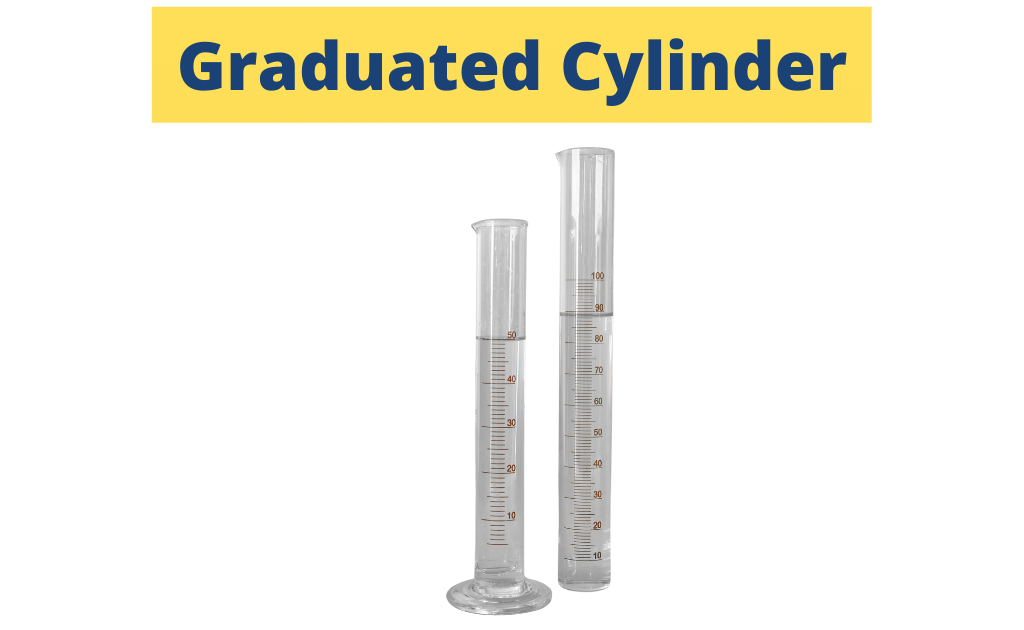Written By Adeel Abbas
Definition of Graduated Cylinder
Table of Contents
A graduated cylinder is a piece of laboratory glassware used to measure the volume of liquids. It consists of a cylindrical tube with a narrow, vertical scale marked on the outside, allowing the user to read the volume of the liquid with a high degree of accuracy.

In this article, we’ll explore the definition, types, sizes, and functions of graduated cylinders, as well as some frequently asked questions about their use.
Like other chemistry lab apparatus Graduated cylinders are often made of glass or plastic, with glass being the preferred material for most scientific applications due to its durability and resistance to chemical attack.
Measurement
To read the volume of a liquid in a graduated cylinder accurately, the reading must be taken at eye level and at the bottom of the meniscus. The meniscus is the curved surface of the liquid that is caused by the attraction of the liquid molecules to the walls of the cylinder.
The most accurate reading that can be taken from the graduated cylinder in the picture is 1 mL. The error in the reading is one tenth of the least figure, which is 0.1 mL.
For example, if the reading is 36.5 mL, the precise value is 36.5 ± 0.1 mL. This means that the actual volume of the liquid is between 36.4 mL and 36.6 mL.
Similarly, if the reading is 40.0 mL, the precise value is 40.0 ± 0.1 mL. This means that the actual volume of the liquid is between 39.9 mL and 40.1 mL.
In both cases, there are 3 significant figures in the reading. The first two digits are certain, and the third digit is an estimate.
Accuracy of a Graduated Cylinder
The accuracy of a graduated cylinder is determined by the size of the graduations and the class of the cylinder.
- The size of the graduations is the smallest volume increment that can be accurately measured. For example, a 100 mL graduated cylinder with 1 mL graduations can accurately measure volumes from 0 mL to 100 mL in increments of 1 mL.
- The class of the cylinder indicates its accuracy. Class A graduated cylinders are more accurate than class B graduated cylinders. Class A cylinders have a tolerance of ±0.02 mL, while class B cylinders have a tolerance of ±0.08 mL.
Types of Graduated Cylinders
There are two main types of graduated cylinders: tall-form and short-form. Tall-form cylinders have a height-to-diameter ratio of about 2:1, meaning they are twice as tall as they are wide.
Short-form cylinders, on the other hand, have a height-to-diameter ratio of about 1:1, making them shorter and wider than tall-form cylinders. Short-form cylinders are often used for more precise measurements of smaller volumes, while tall-form cylinders are better suited for larger volumes.
Sizes of Graduated Cylinders
Graduated cylinders come in a wide range of sizes, typically ranging from 10 milliliters (mL) to 2,000 mL. The size of the cylinder will determine the maximum volume of liquid that the cylinder can hold.
The most common sizes are 10 mL, 25 mL, 50 mL, 100 mL, 250 mL, and 500 mL. Smaller cylinders are typically used for more precise measurements, while larger cylinders are used for measuring larger volumes of liquids.
Glass graduated cylinders are available in three sizes: 500 mL, 1000 mL, and 2000 mL. These cylinders are made from borosilicate glass, which is a type of glass that is resistant to heat and chemicals.
The scales on glass graduated cylinders are typically marked in 5 mL, 10 mL, and 20 mL increments.
Plastic graduated cylinders are also available in a variety of sizes. These cylinders are typically made from polypropylene, which is a type of plastic that is resistant to chemicals.
The scales on plastic graduated cylinders are typically marked in 1 mL, 2 mL, and 5 mL increments.
Uses of Graduated Cylinders
Measuring cylinders performs following functions in lab:
- Measuring cylinders are used to measure the volume of liquids, solids, and mixtures.
- They can also be used to mix liquids and to pour liquids from one container to another.
- Graduated cylinders are made of glass or plastic and come in a variety of sizes.
- When using a graduated cylinder, it is important to read the scale at the bottom of the meniscus.
FAQs
How do you read a graduated cylinder?
To read a graduated cylinder, simply read the scale at the level of the liquid. The scale is marked in milliliters or other units of volume, and the volume is read to the nearest division of the scale.
How do you use a graduated cylinder?
To use a graduated cylinder, fill it with the liquid to be measured, making sure that the bottom of the meniscus (the curved surface of the liquid) is at the desired level on the scale. Then, read the volume of the liquid from the scale.
How do you find the volume of water in a graduated cylinder?
To find the volume of water in a graduated cylinder, simply read the volume from the scale at the level of the water. Make sure to take into account the meniscus when reading the volume.
What does a graduated cylinder measure?
Graduated Cylinders measures volume of different solvents, mixtures, and solutions.